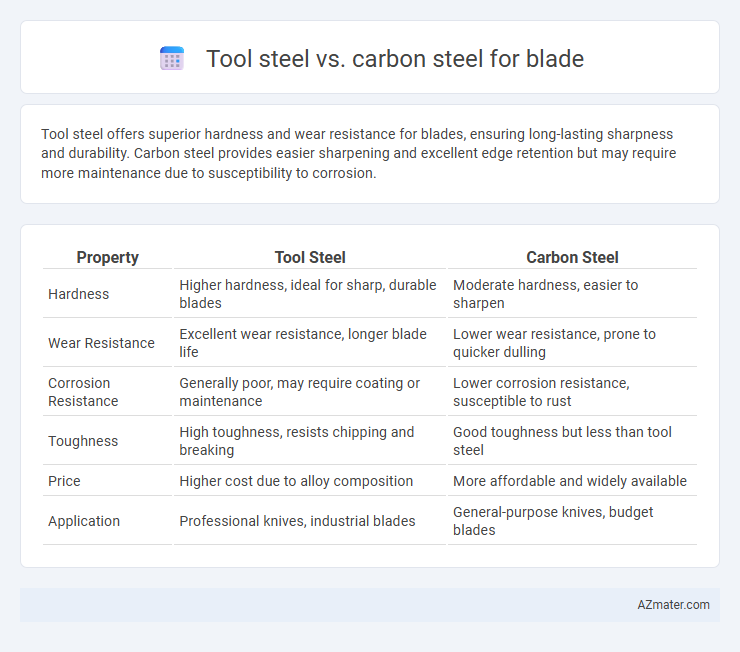Tool steel offers superior hardness and wear resistance for blades, ensuring long-lasting sharpness and durability. Carbon steel provides easier sharpening and excellent edge retention but may require more maintenance due to susceptibility to corrosion.
Table of Comparison
| Property | Tool Steel | Carbon Steel |
|---|---|---|
| Hardness | Higher hardness, ideal for sharp, durable blades | Moderate hardness, easier to sharpen |
| Wear Resistance | Excellent wear resistance, longer blade life | Lower wear resistance, prone to quicker dulling |
| Corrosion Resistance | Generally poor, may require coating or maintenance | Lower corrosion resistance, susceptible to rust |
| Toughness | High toughness, resists chipping and breaking | Good toughness but less than tool steel |
| Price | Higher cost due to alloy composition | More affordable and widely available |
| Application | Professional knives, industrial blades | General-purpose knives, budget blades |
Introduction to Tool Steel and Carbon Steel Blades
Tool steel blades offer superior hardness, wear resistance, and edge retention compared to carbon steel blades, making them ideal for high-performance cutting tools. Carbon steel blades are known for their excellent sharpness and ease of sharpening but require more maintenance to prevent rust and corrosion. The choice between tool steel and carbon steel blades depends on factors such as durability, cutting application, and maintenance preferences.
Composition Differences: Tool Steel vs Carbon Steel
Tool steel contains higher amounts of alloying elements such as tungsten, molybdenum, chromium, and vanadium, which enhance hardness, wear resistance, and heat resistance compared to carbon steel. Carbon steel primarily consists of iron and varying concentrations of carbon, typically ranging from 0.6% to 1.0%, providing good strength and edge retention but less resistance to corrosion and heat. The enhanced alloy content in tool steel improves toughness and durability, making it ideal for high-performance blades, while carbon steel blades excel in affordability and ease of sharpening.
Hardness and Edge Retention Comparison
Tool steel typically offers higher hardness levels, often ranging from 55 to 65 HRC, which significantly enhances edge retention compared to carbon steel. Carbon steel blades, with hardness usually between 50 and 60 HRC, are easier to sharpen but tend to lose their edge faster under heavy use. The superior wear resistance of tool steel makes it the preferred choice for blades requiring long-lasting sharpness in demanding applications.
Toughness and Durability in Blade Applications
Tool steel offers superior toughness and durability compared to carbon steel in blade applications due to its higher alloy content, including elements like chromium, vanadium, and molybdenum that enhance wear resistance and edge retention. Carbon steel provides good toughness but tends to wear faster and requires more frequent maintenance, making it less ideal for heavy-duty or high-use blades. The advanced heat treatment processes for tool steels optimize hardness and toughness balance, resulting in blades that maintain sharpness longer and withstand impact better than standard carbon steel blades.
Corrosion Resistance: Which Steel Performs Better?
Tool steel generally offers superior corrosion resistance compared to carbon steel due to its alloying elements such as chromium, vanadium, and molybdenum that enhance oxidation resistance. Carbon steel, while often tougher and easier to sharpen, is more susceptible to rust without protective coatings or regular maintenance because it lacks these corrosion-resistant alloys. For blade applications requiring durability in humid or wet environments, tool steel typically outperforms carbon steel in resisting corrosion and maintaining edge integrity over time.
Ease of Sharpening and Maintenance
Tool steel blades typically offer superior edge retention and wear resistance compared to carbon steel, but they can be harder to sharpen due to their higher hardness levels. Carbon steel blades are easier to sharpen with basic tools and maintain a keen edge, making them ideal for users who prioritize straightforward maintenance. However, carbon steel requires more frequent care to prevent rust and corrosion, whereas tool steel generally demands less frequent upkeep despite its sharpening challenges.
Cost and Availability Considerations
Tool steel blades generally have higher initial costs compared to carbon steel due to specialized alloying elements like tungsten, vanadium, and cobalt that enhance hardness and wear resistance. Carbon steel is more widely available and affordable, making it a popular choice for budget-conscious users seeking good edge retention and ease of sharpening. Despite the higher price, tool steel blades offer longer lifespan and performance benefits that can justify the investment in professional and heavy-duty cutting applications.
Best Uses: Tool Steel vs Carbon Steel Blades
Tool steel blades are ideal for high-performance cutting tasks requiring exceptional hardness, wear resistance, and edge retention, making them suitable for industrial cutting tools and precision knives. Carbon steel blades excel in applications demanding ease of sharpening and toughness, often preferred for hunting knives, kitchen cutlery, and general-purpose blades. Tool steel's alloy composition enhances durability under heavy use, while carbon steel offers cost-effectiveness and superior edge sharpness in softer, less abrasive environments.
Popular Grades and Their Applications
Popular tool steel grades for blades include A2, D2, and O1, known for their exceptional hardness, wear resistance, and edge retention, making them ideal for heavy-duty cutting tools and precision instruments. Carbon steel blades, such as 1095 and 5160, offer superior toughness and easier sharpening, commonly used in hunting knives, swords, and outdoor utility blades where resilience and quick maintenance are crucial. Tool steels excel in high-stress industrial applications due to their ability to maintain sharpness under repeated use, while carbon steels are favored for traditional knife making and applications requiring a balance of strength and flexibility.
Choosing the Right Steel for Your Blade Needs
Tool steel offers superior hardness, wear resistance, and edge retention compared to carbon steel, making it ideal for blades used in high-performance cutting or demanding environments. Carbon steel blades provide excellent toughness and ease of sharpening, suitable for everyday use and applications requiring quick maintenance. Choosing the right steel depends on the blade's intended use, balancing factors like durability, sharpness retention, and ease of care.

Infographic: Tool steel vs Carbon steel for Blade
 azmater.com
azmater.com